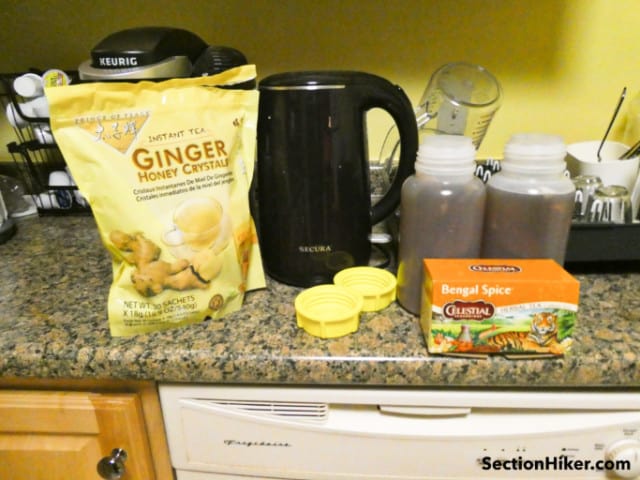There’s an art to winter water hydration and creating an insulation system that keeps your water from freezing, but still maintains it at a drinkable temperature. Like any art form, there are many different systems and gear combinations that you could use to stay hydrated in winter. Here’s an approach to winter water bottle insulation and hydration that works for me and that works with just about any type of wide-mouth bottle, insulation sleeve, and backpack.

Winter Hydration Basics
- You usually have to carry all of the water you need for the day on your person in winter because most water sources are frozen over or buried in snow.
- Most people carry 2 or 3 liters for an all-day hike and augment it by pre-hydrating with 2 liters of liquid intake at breakfast and on the way to the trailhead before the hike starts.
- It’s best to fill your bottles with boiling water. I find an electric kettle works the fastest to heat water.
- While you perspire and exhale considerable moisture in winter, much of it is hard to notice, and you won’t feel thirsty. Nevertheless, you must force yourself to drink and pee. This is best done by observing the color of your urine and keeping track of your rate of water consumption. I like to drink about a liter every two hours. You can delay when you start, by prehydrating before your hike. Dehydration accelerates hypothermia, which you want to avoid, in part because it makes you stupid. Bad decision-making and winter hiking don’t mix well.
- Hydration systems with drink hoses have a tendency to freeze on long day hikes. Hydration systems also limit your ability to measure how much water you’ve ingested since you can’t see the reservoir level and don’t know when it will run dry.
- Wide-mouth water bottles are much less prone to freezing than ones with narrow necks. You can also prevent water bottle caps from freezing shut by turning your bottles upside down.
- Weight is always a consideration on winter hikes. Water is heavy, so it helps to minimize the weight of the containers and insulation used to carry it.
- You can’t drink water if it’s too hot to consume and drinking cold water will chill you. That’s why people just don’t eat snow. I’d advise against using insulated metal bottles for the same reason, unless you want to carry a small thermos of soup, like tomato soup, which can really perk you back up on a frigid day.

Short Term and Long Term Storage
The basic idea is to divide your water into short-term storage and long-term storage. For your short-term storage, keep a single insulated bottle of water in a side pack pocket or attached with a carabiner to your hipbelt: it should stay warm for 2-3 hours.
Forty Below makes a good insulated neoprene bottle holder, but they’ve gotten very expensive due to a worldwide Neoprene shortage. The 32 oz insulated carriers from Nalgene are a less expensive option that also works quite well. If you use a Nalgene bottle, turn it upside down when using the Nalgene insulated carrier. It will fit better.
Keep the rest of your water inside your backpack in an old wool sock or another insulated sleeve, nestled together with the extra insulated clothing you keep in your pack. When you empty the short-term bottle, replace it with one of the full bottles inside your backpack, using the now-empty external sleeve. Your insulated clothing, like a parka or mid-weight synthetic/down jacket, should keep your water quite warm until then. (Hint: put a cheese sandwich next to these bottles and you’ll have a hot melted sandwich for lunch). If you’re worried about the bottles leaking, just wrap them in a plastic bag. I use bread bags.
One of the advantages of this approach is that you only have to buy one insulated water bottle sleeve, instead of several. Your long-term water will also stay a lot hotter inside your pack than if you carried it all externally.
SectionHiker is reader-supported. We only make money if you purchase a product through our affiliate links. Help us continue to test and write unsponsored and independent gear reviews, beginner FAQs, and free hiking guides.
